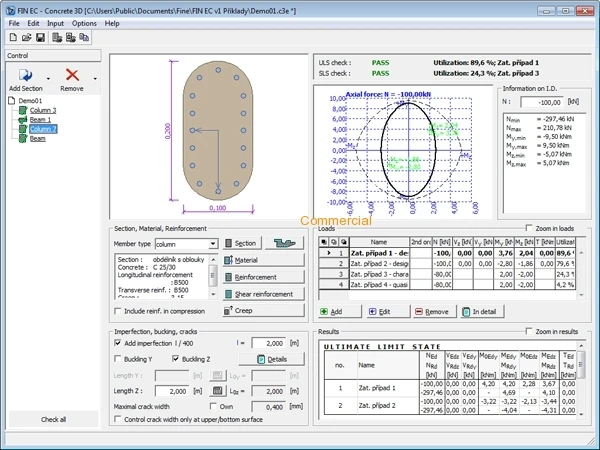The program has been developed for verification of reinforced concrete cross-sections of any shape under action of combinations of forces and bending moments.
Design and check of concrete cross-sections is performed according to EN 1992-1-1 or EN 1992-2 (Eurocode 2).
The program performs check of a designed member under action of any internal forces (normal and shear forces, bending and torsional moments). It generates three-dimensional interaction diagram for combination of normal force and two bending moments. It also performs design and check of reinforcement in a selected section including stirrups and crooks.
Main features of data input:
- large selection of the most common conctrete cross-sections
- possibility to specify your own cross-section using polygonal graphical input tool
- database of strength classes according to EC2 including user-defined material
- database of reinforcement materials including user-defined material
- unlimited number of load cases (combinations) for each cross-section
- recognition of short-term and long-term load cases
- input of longitudinal reinforcement by bottom and top surface of cross-section. Shear reinforcement is determined as stirrups or bent-up bars
- structural rules according to member type (beam, column, slab)
Results
- check of concrete strength class according to the specified exposure class
- check of reinforcement ratio for longitudinal and shear reinforcement
- calculation of minimum cover of reinforcement
- verification of a member or any selected section
- check of selected load case or finding the decisive load case
- check of all load cases in a table
- check of the envelope of all load cases
- member verification with or without the influence of buckling
- possibility of graphical input of load directly in the interaction diagram with instant display of results
- verification of the serviceability limit state (maximum allowable stress in concrete, crack control)
The program works by itself or more efficiently together with FIN 2D and FIN 3D, where you can specify the entire structure and the program calculates deformations and internal forces and sends data to program Concrete 2D. Verifications or modifications of cross-sections or other properties are performed here and then sent back to FIN 3D. Such mutual communication leads to efficient optimization of structure design.


